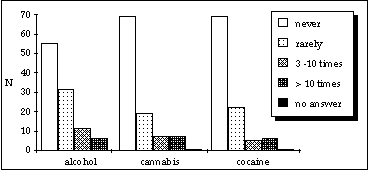Cohen, Peter (1989),
Cocaine use in Amsterdam in non-deviant subcultures. In: Peter Cohen (1990),
Drugs as a social construct. Dissertation. Amsterdam, Universiteit
van Amsterdam. pp. 167-170.
© Copyright 1990 Peter Cohen.
All rights reserved.
14. Work and relations
Peter Cohen
- 14.1 - Introduction
- 14.2 - Drug use and work
- 14.3 - Effects of cocaine use on work and social relations
Table of contents
14.1 Introduction
In personal contacts with many policy makers in the field of drugs one of the frequently mentioned issues about cocaine was influence on job performance and personal relations. There is indeed some evidence that certainly high level use may have considerable adverse effects in this field (Gold et al 1983; Reinarman et al, 1988).
In this chapter we will report our findings on this issue with our sample of experienced users.
14.2 Drug use and work
We asked respondents if they ever were under the influence of any drug during working hours in the last three months. Of the respondents who were employed during the last three months (107 out of 160) half answered affirmatively for alcohol and two thirds had been (on one or more occasions) under influence of cannabis or cocaine at work. We have to keep in mind that 37% of the total sample had artistic or hotel/bar professions, in which working under the influence of some drug is probably considered more acceptable than in other professions (see also table 14.2.b).
To see if the persons who are under influence of one of the mentioned drugs during working hours are the same, we looked especially at those who reported having been under influence more than 3 times during the last three months. We found that 22 respondents had been under influence of one drug more often than 3 times, 7 respondents under influence of 2 different drugs (not necessarily at the same time) and 4 under influence of three different drugs.
Looking at the professions of those who have been under influence of more than one drug during working hours we find bar/hotel employees (4), artistic professions (4) and academic/manager (3). Because there are virtually no figures on the frequency of being under influence of drugs for the total population or subgroups thereof, we cannot say if these frequencies in our sample are high or low.
Table 14.2.a Working under influence of drugs of respondents having employment during last three months.


Table 14.2.b Under the influence of a drug at three or more occasions during working hours in a period of three months prior to interview of respondents having employment, in %.

When we look at being under the influence of cocaine or cannabis or alcohol three or more times during working hours during the three months prior to the interview per professional category we find some interesting differences. In table 14.2.b we have listed only those respondents who were employed during the three months previous to the interview. We selected only the professional categories where values of 5% or over could be found with two of the three listed drugs. Very clearly the respondents working in the hotel/bar and the artistic professions show the highest prevalence of being under the influence of some drug during working hours on three or more occasions during the three months prior to the interview. Since cell sizes are small, this information which conforms to the expectations mentioned at the beginning of this paragraph, should be looked at with some caution.
14.3 Effects of cocaine use on work and social relations
We asked all respondents for whom this was applicable if the use of cocaine either improved or worsened working or partner relations, the quality of work done or finances. We also asked if the use of cocaine had been the cause of divorce.
To start with this last item, this was the case for 20 respondents, or 13.3% of persons for whom this was applicable. This kind of dramatic effect of cocaine should be investigated further, to find out how it works, if other factors are present, and to what degree.
For the other effects of cocaine on work and relations we see that respondents report both negative and positive effects, but negative effects are dominant. The only exception is sexual relations where a small unbalance in the positive direction exists. But partner relations show the largest imbalance in a negative direction. It is clear that for this item, effects of drug use on work and partner relations, more research is needed to understand the dynamics involved.
Table 14.3.a Influence of cocaine on various items

*) N is not always 160 due to missing data or because items were not always applicable to respondents' personal situation.
We have to keep in mind that our population is selected on one variable, that is being an experienced cocaine user. However, this population appeared to be highly experienced with other drugs as well, distinguishing itself markedly on the variable of polydrug use from the general Amsterdam population. Quite certainly our population is not representative on many more aspects of life styles or attitudes. It would be naive to state that these differences are caused by the drug use patterns of our sample alone. It is much more plausible to expect that drug use and many other aspects of life style with our respondents are different because they are different from the general population in many (underlying) variables that have not been the subject of our study. So, even if some subjects would e.g. perceive cocaine use as a cause for their divorce, it is not improbable that an outgoing and more or less promiscuous life style supported by cocaine is much nearer the cause for divorce than cocaine use alone. We have to be very careful not to jump to easy conclusions, precisely as is often the case with the relation between criminality and drugs.
